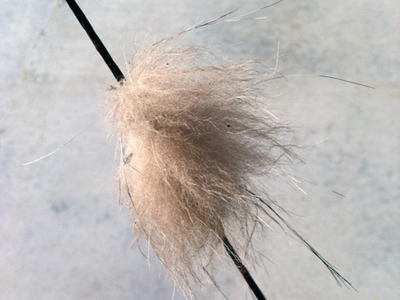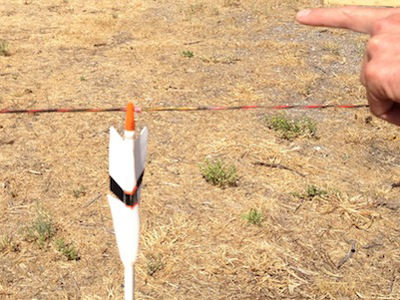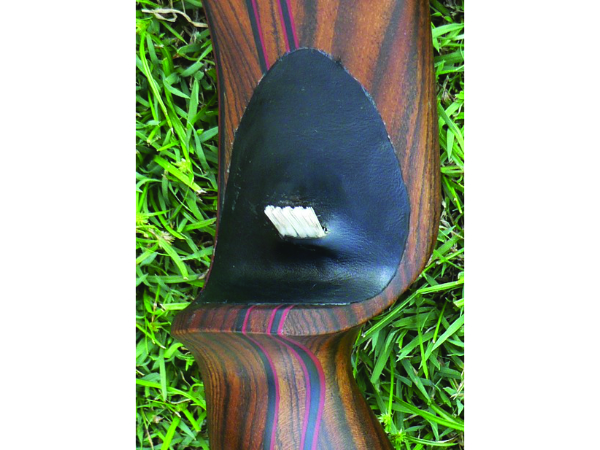This tip requires a bit of radio theory and brain work. The subject is heterodyning. A very basic definition is two different frequencies that are combined to produce two new frequencies: the sum and difference of the two original frequencies. What does this have to do with traditional archery equipment? Well, knowing this fact helps us to quiet our bows.
Most of us have tried various types of string silencers. Some folks have trouble getting any of them to work. Here is the solution, no matter the type of bow or type of silencer material. Measure the distance from where the string leaves the bow limbs top and bottom. Divide that distance by four and also by three. For instance and simplicity let us say your measured length is 60 inches; 60 divided by four equals 15 inches and divided by three equals 20 inches.
Attach your top string silencer 15 inches down from where the string leaves the bow, and attach the bottom silencer 20 inches up from where it leaves the bow. Doing so cancels out the sustaining frequencies that would make a naked string hum or twang when released. The quartering distance (15 inches) cancels out all even multiples of the frequencies and the distance in thirds cancels out all the odd multiples of the frequencies. The end result is a string that resists vibration after the shot and goes thump instead of twang.
By the way, the same principle applies to whistling broadheads. Using a thin strip of fine sandpaper to buff the leading edges of the rear of the vent cutouts will kill the sharp edges that create the whistle. Sometimes only one vent has to be done, sometimes one a bit more than the other.







Amazing!
I have heard something along these lines before and it makes sense. The broadhead issue I haven’t heard of before and is a good idea too.
John Borgeson asked me to post the following for him.
Food For Thought
I would like to take an opportunity write a few lines to comment on the Tip of the Week web post on Heterodyning.
First a definition of heterodyning:
Heterodyning is a signal processing technique invented in 1901 (This is also the date where the word was first used) by Canadian inventor-engineer Reginald Fessenden. Heterodyning creates new frequencies by combining or mixing two frequencies. Heterodyning is used to shift one frequency range into another, new one, and is also involved in the processes of modulation and demodulation.
A working definition of heterodyning is: To generate new frequencies by mixing two or more signals in a nonlinear device such as a vacuum tube, transistor, or diode mixer.
Below is a diagram of a simple heterodyne system. I think they left out the bow and string in this particular diagram. What do you think?
Now my question is this: What part of my bow is the vacuum tube, or the transistor, or the diode mixer?
I don’t know about you fellows, but my bows are all simple “stick” and “string” combinations. That includes my 2 piece and 3 piece takedown bows. Maybe this is just too complicated for me???
The non-linear device is the string. On release it will generate a standing wave over time at its harmonic frequency.
That is, if you had a microphone pointed at the string (really at the bow), and hooked it up to an oscilloscope you’d see a sinusoidal waveform display during the loosing of an arrow and the string’s return to rest.
What they’re determining to do here is to break up that waveform by changing the string’s harmonic. In this case they’re causing the string to produce two different oscillations at (roughly) 180° phases, which will help cancel the noise of the string.
This explanation of heterodyning is a brilliant adaptation from the technical world of radio frequency technology applied to the primitive world of traditional archery. Sort of like teaching a very old dog a new trick. Interesting meets the practical application. Thank you, Rocky…
What measurement would be used when “Stiktamers” are involved? I have used them for several years and like them. I just replaced my string and the measurement from bow limb touch to bow limb touch is 48″. The measurement from Stiktamer touch to Stiktamer touch is 43″. The shorter distance would be the true span of string? Maybe?
I think your measurement would be 48″ so place one silencer 12″ from the top, and the other one 16″ from the bottom. It might take some experimenting to get your bow as quiet as can be. I’m just not sure how the stiktamers affect the vibration of your string. Feel free to share your findings here in case others have the same question.
Thanks, Rocky!
I never liked the suck it and see approach to placing silencers and your solution was elegant. The reduction in string generated sound was far better than I would ever have expected – damping two frequencies as you say.
Another point. With my Dyna 97 string, the “furring” that occurs near the centre serving hasn’t returned since I installed silencers in the 25%/33% locations. I’m thinking that at a point where there is a diameter change in the string (string to serving) there will be a stress riser. Lateral shocks (i.e. vibration) would logically be more damaging to bow string fibres than an axial shock (string reaching full extension). We’ll see with time if this lasts
So how exactly does one set it up on a 56 inch bow so that it doesn’t get into the serving?
One silencer goes 18.75″ from the bottom, and one goes 14″ from the top. That would leave 23″ in between them. How far does your serving go?
I set my silencers at 1/4 and 1/5 (instead of 1/3). This follows the same odd/even frequency principle and keeps the upper silencer further from my line of site.
Be sure you measure the string length for the calculation from the points where the string rests on the bow not its overall (drawn) length. Also note the 1/3 and 1/5 placement distances are to the center of the silencer not where you start winding it in.
My serving is 9.5” it is a black widow string D97. The article state to measure where the string leaves the bow, can you please be more specific? The way I measured it ran it into the serving. Thanks
Look for where the string comes away from the limbs and measure that distance. This will be less than the length of your bow, or even the full length of your string. Divide that number by three and four, and set the silencers accordingly. Let’s say your measurement is 52″, one would go 13 inches from the top and the other about 17″ from the bottom. There should be 22 inches between silencers. Which silencer is going into the serving?
Finally. I have been waiting for this solution for years. I have a Hoyt Buffalo that I rarely shoot anymore due to the fact that it can sound just like a nail gun. Great bow, hard to silence. I recently switched from beaver balls to wool silencers. That combined with this trick makes a huge difference! Still needs some work but I’m happy to be shooting that bow again.
With cat whiskers you can slide them up or down as you shoot and find out what works best for your particular bow.
I’ve found that much closer to the tips than I expected work nicely for me.
Results will vary.
Dang….Heterodyning…. glad we cleared that up. I always thought that meant a straight guy taking his wife out to dinner. Guess you learn something every day.
I have a Black Hunter hybrid longbow as a backup bow. Cant seem to tune out the noise. I will definitely be trying this.
I have an old string that I really like and it suits my bow to a tee. It came with Navajo wool silencers attached, equidistant from the limb tips, not in the heterodyning position. It shoots fairly quietly but I wonder what would happen if I attached just one of those little rubber silences to either the upper or lower part of the string. Would this create a heterodyning wave length? Stay tuned.
Well, I’m not really clear on the technical ‘why’ or ‘how’ it works, but I saw and saved this article back in 2018, began using it and been successfully using it on my strings since. Thanks, Tradbow!
This method works folks, amazingly well. All my strings have their silencers placed according to this method for my static recurves now with a noticeable reduction in sound.
I put beaver balls on one of my homemade R/D longbows. Before I put them on it didn’t have a lot of noise but it is dead quiet.
Another thing I noticed was it actually improved my accuracy by deadening any vibration/harmonics. All my bows I make now have beaver fur on the strings.
I have not tried this method. I locate my silencers by measuring just as you do here, top string contact point to bottom contact point, then divide by five and then by six. This locates the fifth and sixth harmonic points. Then I place the silencers between these two points. Works very well.